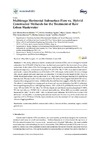Identificador persistente para citar o vincular este elemento:
https://accedacris.ulpgc.es/jspui/handle/10553/73629
| Título: | Multistage horizontal subsurface flow vs. hybrid constructedwetlands for the treatment of raw urban wastewater | Autores/as: | Herrera-Melián, José Alberto Mendoza-Aguiar, Mónica Guedes Alonso, Rayco García-Jiménez, Pilar Carrasco-Acosta, Marina Ranieri, Ezio |
Clasificación UNESCO: | 330810 Tecnología de aguas residuales | Palabras clave: | Gravel Horizontal Flow Organic Mulch Sand Shallow Constructed Wetland, et al. |
Fecha de publicación: | 2020 | Publicación seriada: | Sustainability (Switzerland) | Resumen: | In this study, pilot-scale hybrid constructed wetlands (CWs) and multistage horizontal subsurface flow CWs (HF CWs) have been studied and compared for the treatment of raw urban wastewater. In the hybrid CWs, the first stage was a mulch-based horizontal subsurface flow CW and the second stage was a vertical subsurface flow CW (VF CW). The VF CWs were used to determine if sand could improve the performance of the hybrid CW with respect to the mulch. In the multistage HFs, mulch, gravel and sand were used as substrates. The effect of water height (HF10: 10 cm vs. HF40: 40 cm) and surface loading rate (SLR: 12 vs. 24 g Chemical Oxygen Demand (COD)/m2d) has been studied. The results show that the use of sand in the vertical flow stage of the hybrid CW did not improve the average performance. Additionally, the sand became clogged, while the mulch did not. The effect of water height on average pollutant removal was not determined but HF10 performed better regarding compliance with legal regulations. With a SLR of 12 g COD/m2d, removals of HF10 were: 79% for COD, 75% for NH4+-N, 53% for dissolved molybdate-reactive phosphate-P (DRP), 99% for turbidity and 99.998% for E. coli and total coliforms. When SLR was doubled, removals decreased for NH4+-N: 49%, DRP:-20%, E coli and total coliforms: 99.5-99.9%, but not for COD (85%) and turbidity (99%). Considering the obtained results and the simplicity of the construction and operation of HFs, HF10 would be the most suitable choice for the treatment of raw urban wastewater without clogging problems. | URI: | https://accedacris.ulpgc.es/handle/10553/73629 | ISSN: | 2071-1050 | DOI: | 10.3390/su12125102 | Fuente: | Sustainability (Switzerland) [EISSN 2071-1050], v. 12, 5102, (Junio 2020) |
| Colección: | Artículos |
Citas SCOPUSTM
18
actualizado el 08-jun-2025
Citas de WEB OF SCIENCETM
Citations
16
actualizado el 18-ene-2026
Visitas 5
96
actualizado el 11-ene-2026
Descargas
132
actualizado el 11-ene-2026
Google ScholarTM
Verifica
Altmetric
Comparte
Exporta metadatos
Los elementos en ULPGC accedaCRIS están protegidos por derechos de autor con todos los derechos reservados, a menos que se indique lo contrario.
